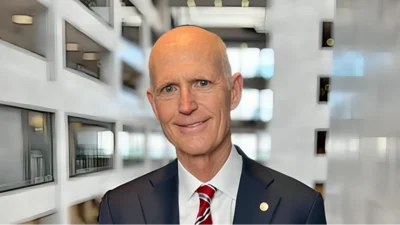Last summer, two interns got a head start on their careers through a partnership between the Office of Legacy Management (LM) and the Mentorship for Environmental Scholars (MES) Program.
The U.S. Department of Energy’s (DOE) MES program is an 8 to 10-week, paid summer internship that provides underrepresented college students with research experience in environmental science, environmental justice, and environmental policy.
LM scientist Angelita Denny said the MES internship program provides students with the opportunity to meaningfully work with professionals in their field.
“DOE creates a personalized project for each MES intern based on their interest, so they receive hands-on experience that helps them build their résumé,” Denny said.
Interns Mikayla Bia and Jacob Henry worked with LM and LM Strategic Partners on a number of projects. Henry has earned a bachelor’s degree in chemical engineering from the University of Arizona. Bia is pursuing an associate degree in pre-engineering at Diné College in Tsaile, Arizona.
Bia worked closely with Denny, a scientist on the Uranium Mill Tailings Radiation Control Act (UMTRCA) Team, as well as with Mary Young, a scientist on the Uranium Mine Team. Bia observed Defense-Related Uranium Mines (DRUM) field teams perform verification and validation (V&V) activities in Utah, including inventories, environmental sampling, and in-field quality assurance.
“At the second mine, Mikayla helped the team collect the total disturbed area and take photos of some features,” Young said. “Throughout the visit, there were good conversations among the team members and Mikayla, with the team asking about Navajo Nation culture and traditional ecological knowledge.”
Young also took Bia to the high mine density area of Moab, Utah, to show her many of the different hazardous features DRUM teams encounter at the sites where they work.
While driving in between sites, Young described to Bia the work of the DRUM program, responsibilities of team members, and general field work procedures and planning. The two also discussed Bia’s interests, which gave her some ideas for her summer research project. Young suggested to Bia that she might compile a list of cultural and traditional knowledge DRUM teams should be aware of during V&V, such as plants used in ceremonies and medicines, taboo topics, and general beliefs, to help avoid any inadvertent disrespect to the Navajo people.
With Denny, Bia visited the Monticello, Utah, Site and attended a Navajo-Hopi-DOE quarterly meeting in Gallup, New Mexico. Bia also visited the Slick Rock Disposal/Processing Site in southwestern Colorado. On that visit, she met and interacted with LM Director Carmelo Melendez, and Gordon Clark and Chuck Denton of the Uranium Mine Team.
“Those will be conversations I will never forget,” Bia said. “I was lucky to be able to receive both life and educational advice and that I will cherish forever.”
Now that her internship has ended, Bia said the experience has given her the experience of knowing how to be independent in the workplace.
“It has taught me the transition of going from working among others within my age range to learning to work with my mentors and other DOE employees on a professional level,” she said.
Henry spent most of his internship last summer working with Dr. Ray Johnson, a senior LM Strategic Partner geochemist at the Grand Junction Office. Henry helped Johnson graph and analyze data from the Riverton, Wyoming, Disposal Site in support of the Applied Studies and Technology (AS&T) program.
Henry used a technique developed by the University of Wisconsin-Milwaukee to graph and analyze contaminant release rates after the injection of clean water. Henry said the goal of his involvement in the project was to build on prior work to show uranium and molybdenum release rates, which will be used to evaluate a new compliance strategy for the Riverton site.
“These concentration profiles of the wells I made were converted into charts for presentations,” he said. “Through this process I polished my skills in Microsoft Excel as well as Visual Basic for Applications (VBA) to create the graphs showing the various concentration profiles based on different parameters.”
Henry gained experience with geochemical modeling software that analyzed data to create possible chemical reactions with the sediment composition and created graphs of the chemicals in groundwater. He presented on the topic at the Geological Society of America Connects 2022 in Denver in October.
Henry said he gained valuable insight from his visits to various disposal sites in the Department of Energy complex, where he learned background information on the history of uranium disposal, cleanup, and monitoring of former mining, milling, and disposal sites.
“What the internship at the Office of Legacy Management did was educate me about the work done so far in dealing with the effects of uranium mining on the environment, as well as the community,” Henry said. “However, working with Ray on his project, I realize still there is a lot to be done towards helping and resolving the secondary effects that are experienced in the community and the environment.”
Original source can be found here.








